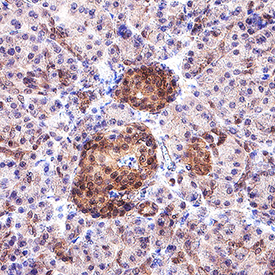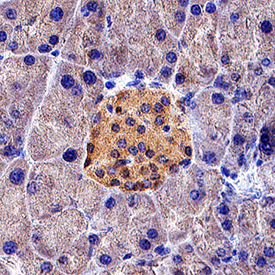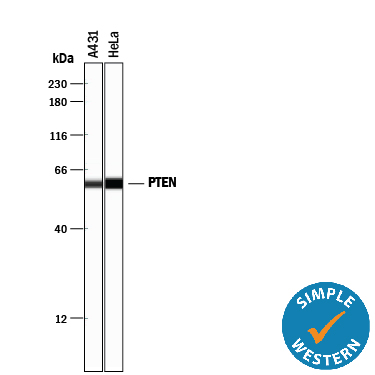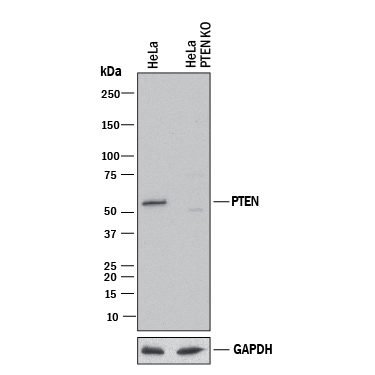Human/Mouse/Rat PTEN Antibody Summary
Ser385-Val403
Accession # P60484
Applications
Please Note: Optimal dilutions should be determined by each laboratory for each application. General Protocols are available in the Technical Information section on our website.
Scientific Data
 View Larger
View Larger
Detection of Human/Mouse/Rat PTEN by Western Blot. Western blot shows lysates of mouse and rat brain tissue, A431 human epithelial carcinoma cell line, and MRC-5 human embryonic lung fibroblast cell line. PVDF membrane was probed with 0.1 µg/mL Rabbit Anti-Human/Mouse/Rat PTEN Antigen Affinity-purified Polyclonal Antibody (Catalog # AF847) followed by HRP-conjugated Anti-Rabbit IgG Secondary Antibody (Catalog # HAF008). For additional reference, recombinant human PTEN (5 ng) was included. A specific band for PTEN was detected at approximately 54 kDa (as indicated). This experiment was conducted under reducing conditions and using Immunoblot Buffer Group 4.
 View Larger
View Larger
PTEN in Human Pancreas. PTEN was detected in immersion fixed paraffin-embedded sections of human pancreas using Rabbit Anti-Human/Mouse/Rat PTEN Antigen Affinity-purified Polyclonal Antibody (Catalog # AF847) at 3 µg/mL for 1 hour at room temperature followed by incubation with the Anti-Rabbit IgG VisUCyte™ HRP Polymer Antibody (VC003). Before incubation with the primary antibody, tissue was subjected to heat-induced epitope retrieval using Antigen Retrieval Reagent-Basic (CTS013). Tissue was stained using DAB (brown) and counterstained with hematoxylin (blue). Specific staining was localized to cytoplasm in islet cells. Staining was performed using our protocol for IHC Staining with VisUCyte HRP Polymer Detection Reagents.
 View Larger
View Larger
PTEN in Mouse Pancreas. PTEN was detected in immersion fixed paraffin-embedded sections of mouse pancreas using Rabbit Anti-Human/Mouse/Rat PTEN Antigen Affinity-purified Polyclonal Antibody (Catalog # AF847) at 3 µg/mL for 1 hour at room temperature followed by incubation with the Anti-Rabbit IgG VisUCyte™ HRP Polymer Antibody (VC003). Before incubation with the primary antibody, tissue was subjected to heat-induced epitope retrieval using Antigen Retrieval Reagent-Basic (CTS013). Tissue was stained using DAB (brown) and counterstained with hematoxylin (blue). Specific staining was localized to cytoplasm in islet cells. Staining was performed using our protocol for IHC Staining with VisUCyte HRP Polymer Detection Reagents.
 View Larger
View Larger
Detection of PTEN in Human PBMC lymphocytes by Flow Cytometry. Human peripheral blood lymphocytes were stained with Rabbit Anti-Human/Mouse/Rat PTEN Antigen Affinity-purified Polyclonal Antibody (Catalog # AF847, filled histogram) or control antibody (Catalog # AB-105-C, open histogram), followed by Phycoerythrin-conjugated Anti-Rabbit IgG Secondary Antibody (Catalog # F0110). To facilitate intracellular staining, cells were fixed with paraformaldehyde and permeabilized with saponin.
 View Larger
View Larger
Detection of Human PTEN by Simple WesternTM. Simple Western lane view shows lysates of A431 human epithelial carcinoma cell line and HeLa human cervical epithelial carcinoma cell line, loaded at 0.2 mg/mL. A specific band was detected for PTEN at approximately 60 kDa (as indicated) using 1 µg/mL of Rabbit Anti-Human/Mouse/Rat PTEN Antigen Affinity-purified Polyclonal Antibody (Catalog # AF847). This experiment was conducted under reducing conditions and using the 12-230 kDa separation system.
 View Larger
View Larger
Western Blot Shows Human PTEN Specificity by Using Knockout Cell Line. Western blot shows lysates of HeLa human cervical epithelial carcinoma parental cell line and PTEN knockout HeLa cell line (KO). PVDF membrane was probed with 0.1 µg/mL of Rabbit Anti-Human/Mouse/Rat PTEN Antigen Affinity-purified Polyclonal Antibody (Catalog # AF847) followed by HRP-conjugated Anti-Rabbit IgG Secondary Antibody (Catalog # HAF008). A specific band was detected for PTEN at approximately 55 kDa (as indicated) in the parental HeLa cell line, but is not detectable in knockout HeLa cell line. GAPDH (Catalog # AF5718) is shown as a loading control. This experiment was conducted under reducing conditions and using Immunoblot Buffer Group 1.
Reconstitution Calculator
Preparation and Storage
- 12 months from date of receipt, -20 to -70 °C as supplied.
- 1 month, 2 to 8 °C under sterile conditions after reconstitution.
- 6 months, -20 to -70 °C under sterile conditions after reconstitution.
Background: PTEN
The tumor suppressor gene PTEN (phosphatase and tensin homolog deleted on chromosome 10), also known as MMAC1 (mutated in multiple advanced cancers 1), encodes a phosphatase that contains the catalytic signature motif (HCXXGXXRS/T) found in all members of the protein tyrosine phosphatase family. In vitro, the recombinant PTEN has both lipid phosphatase and protein phosphatase activities (1, 2). Interestingly, accumulating evidence has shown that the tumor suppressor activity of PTEN relies on its ability to dephosphorylate phosphatidylinositol (3, 4, 5)-triphosphate specifically at position 3 of the inositol ring (3). This activity reduces the levels of phosphatidylinositol (3, 4, 5)-triphosphate which is specifically produced from phosphatidylinositol (4, 5)-diphosphate by PI 3-kinase upon activation by a variety of stimuli. Therefore, PTEN antagonizes PI 3-kinase-induced downstream signaling events and cellular processes including cell growth, apoptosis and cell motility. In vivo, the importance of PTEN catalytic activity in its tumor suppressor functions is underscored by the fact that the majority of PTEN missense mutations detected in tumor specimens target the phosphatase domain and cause a loss in PTEN phosphatase activity (4).
- Maehama, T. and J. Dixon (1998) J. Biol. Chem. 273:13375.
- Das, S. et al. (2003) Proc. Natl. Acad. Sci. USA 100:7491.
- Myers, M. et al. (1998) Proc. Natl. Acad. Sci. USA 95:13513.
- Waite, K. and C. Eng (2002) Am. J. Hum. Genet. 70:829.
Product Datasheets
Product Specific Notices
This product is covered by the following U.S. patent: USSN # 10/299,003.Citations for Human/Mouse/Rat PTEN Antibody
R&D Systems personnel manually curate a database that contains references using R&D Systems products. The data collected includes not only links to publications in PubMed, but also provides information about sample types, species, and experimental conditions.
7
Citations: Showing 1 - 7
Filter your results:
Filter by:
-
Nickel's Role in Pancreatic Ductal Adenocarcinoma: Potential Involvement of microRNAs
Authors: M Mortoglou, L Mani?, A Buha Djord, Z Bulat, V ?or?evi?, K Manis, E Valle, L York, D Wallace, P Uysal-Onga
Toxics, 2022-03-21;10(3):.
Species: Human
Sample Types: Cell Lysates
Applications: ELISA Development -
A scalable Drosophila assay for clinical interpretation of human PTEN variants in suppression of PI3K/AKT induced cellular proliferation
Authors: P Ganguly, L Madonsela, JT Chao, CJR Loewen, TP O'Connor, EM Verheyen, DW Allan
PloS Genetics, 2021-09-07;17(9):e1009774.
Species: Drosophila
Sample Types: Whole Tissue
Applications: IHC -
TGF-? induces phosphorylation of phosphatase and tensin homolog: implications for fibrosis of the trabecular meshwork tissue in glaucoma
Authors: N Tellios, JC Belrose, AC Tokarewicz, C Hutnik, H Liu, A Leask, M Motolko, M Iijima, SK Parapuram
Sci Rep, 2017-04-11;7(1):812.
Species: Human
Sample Types: Cell Lysates
Applications: Western Blot -
A novel role for GSK3? as a modulator of Drosha microprocessor activity and MicroRNA biogenesis
Nucleic Acids Res, 2017-03-17;0(0):.
Species: Human
Sample Types: Cell Lysates
Applications: Western Blot -
Biomarker analysis of the NeoSphere study: pertuzumab, trastuzumab, and docetaxel versus trastuzumab plus docetaxel, pertuzumab plus trastuzumab, or pertuzumab plus docetaxel for the neoadjuvant treatment of HER2-positive breast cancer
Authors: G Bianchini, A Kiermaier, GV Bianchi, YH Im, T Pienkowski, MC Liu, LM Tseng, M Dowsett, L Zabaglo, S Kirk, T Szado, J Eng-Wong, LC Amler, P Valagussa, L Gianni
Breast Cancer Res, 2017-02-09;19(1):16.
Species: Human
Sample Types: Whole Tissue
Applications: IHC -
Tumor suppressor PTEN in breast cancer: heterozygosity, mutations and protein expression.
Authors: Kechagioglou, Petros, Papi, Rigini M, Provatopoulou, Xeni, Kalogera, Eleni, Papadimitriou, Elli, Grigoropoulos, Petros, Nonni, Aphrodit, Zografos, George, Kyriakidis, Dimitrio, Gounaris, Antonia
Anticancer Res, 2014-03-01;34(3):1387-400.
Species: Human
Sample Types: Cell Lysates
Applications: Western Blot -
Basal activation of p70S6K results in adipose-specific insulin resistance in protein-tyrosine phosphatase 1B -/- mice.
Authors: Ruffolo SC, Forsell PK, Yuan X, Desmarais S, Himms-Hagen J, Cromlish W, Wong KK, Kennedy BP
J. Biol. Chem., 2007-07-30;282(42):30423-33.
Species: Mouse
Sample Types: Cell Lysates
Applications: Western Blot
FAQs
No product specific FAQs exist for this product, however you may
View all Antibody FAQsReviews for Human/Mouse/Rat PTEN Antibody
Average Rating: 5 (Based on 1 Review)
Have you used Human/Mouse/Rat PTEN Antibody?
Submit a review and receive an Amazon gift card.
$25/€18/£15/$25CAN/¥75 Yuan/¥2500 Yen for a review with an image
$10/€7/£6/$10 CAD/¥70 Yuan/¥1110 Yen for a review without an image
Filter by:





